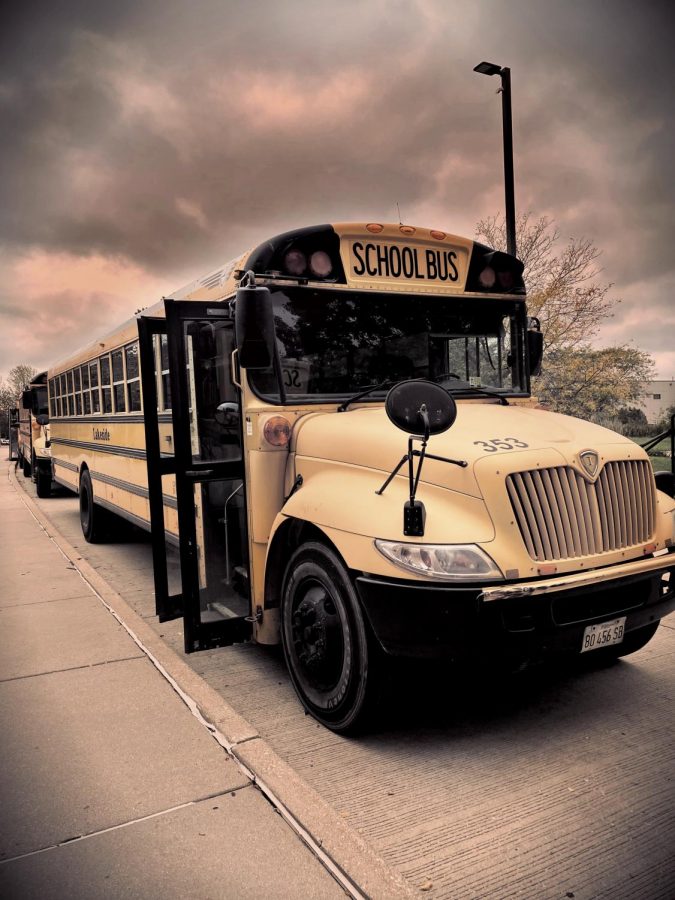Fewer wheels go round and round
Buses line up at 3:25 p.m. to take the first route of students home.
Mornings are really important to Jaya Conner (9). Mornings are when she gets homework done and prepares for her school day.
However, due to the nationwide bus driver shortage, there is little time for her to do these things.
The bus shortage started at the beginning of the school year and has resulted in some morning routes running earlier and some afternoon routes beginning later.
Conner said her morning bus route was greatly altered due to the shortage.
Previously, her bus arrived at 7:50 a.m. The bus now arrives 30 minutes earlier, at 7:20 a.m.
This change has led to fewer students on her bus.
“I’ve seen an enormous decline [in students] on our bus,” Conner said. “Our bus used to have full seats, everyone [sitting] two to a seat, every single seat there, and now [at most] 10-15 kids on the bus in total.”
Ginger De La Garza, the LST Secretary in charge of attendance and transportation, shared that some buses are taking multiple routes for VHHS, which has led to these changes in the arrival time.
“In the morning a couple of bus routes begin at 7:15 a.m, then they come and drop the kids off. Then they go back and they pick up the second group of kids,” she said.
Afternoon routes have also been changed, according to De La Garza.
“In the afternoon, we’ll have bus routes that start at 3:35 p.m… [then] the same bus driver comes back to pick up another route and [that route] generally leaves at about 4:05 p.m.”
Morning and afternoon routes are not the only ones affected by the shortage, as sports teams are also feeling the effects.
Steve Szabo, math teacher and head Boys Cross Country coach, shared a problem his team encountered as a result of the shortage. A bus that needed to take his team to a meet arrived 45 minutes late.
“The boys wound up running fairly well, considering the circumstances,” Szabo said, “But, we would generally like to get to a meet at least an hour beforehand, to give them a proper warm up. But with only about 18 minutes to find a spot to put our stuff, warm up and get to the start line, it was very hard.”
Szabo shared that there doesn’t seem to be an end to the shortage anytime soon. He is planning on the shortage being an ongoing issue to prepare for future meets. De La Garza was also uncertain about the timetable for this shortage.
“We’re hoping that [the shortage] is short-lived and that [Lakeside Transportation] can start hiring more drivers. But they really don’t know how long it’s going to [take] to be back to fully staffed,” she said.
De La Garza explained that the shortage began when schools went remote as a result of the COVID-19 pandemic.
“The [bus] drivers were either applying for unemployment or seeking jobs elsewhere, and when [Lakeside Transportation] went to call them back, they were already employed by somebody else,” she said.
De La Garza emphasized that Lakeside Transportation has always been understaffed, but this shortage is widespread and is much harder to manage for the company.
Szabo speculated that the number of requirements to be a bus driver may contribute to the difficulty in recruiting new employees.
A contact of De La Garza at Lakeside Transportation shared some requirements that bus drivers must have. These include having a driver’s license for three consecutive years, passing a background check, fingerprints, and DOT physical.
To earn a Commercial Driver’s License, which is required for driving large vehicles, a series of written tests and onsite driving tests are required. Applicants must also attend a series of classes to go through equipment training, special needs training, and sensitivity training.
Finally, applicants will have ride-alongs where a supervisor will show the applicant what is expected of them once they become a part of the staff. De La Garza and the contact at Lakeside Transportation Service did not make statements regarding whether or not these requirements played into the driver shortage.
“I think that getting the kids to and from school safely is the main priority,” said De La Garza.

